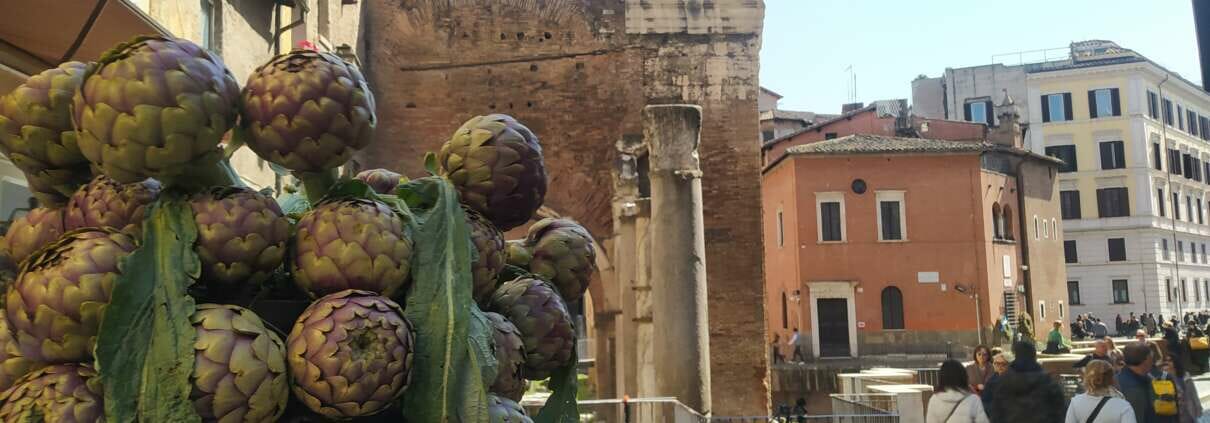Roman artichoke festival in the Jewish ghetto of Rome
The Roman Artichoke Festival for the first time from 6 to 8 April 2022 in Rome. Three days dedicated to artichoke, the King of Roman vegetables. Directly in the heart of the Jewish quarter of Rome, in Portico d’Ottavia.

Towers of artickokes in Portico d’Ottavia
This year, three days of celebration are added to the classic celebrations in Ladispoli. From 6 to 8 April, all the restaurants of the Jewish Ghetto of Rome come together to offer their tribute to His Majesty the Roman artichoke.
Offering a tasting menu that will show the various and multiple variations of the artichoke in tasty recipes of exceptional value. From artichoke alla romana, to artichoke alla giudia, from artichoke salad to fried golden ones.
The Jewish quarter of Rome will bring the artichoke in triumph, especially the Romanesque one. It is a variety different from the others, as can be seen from the same shape.
Tourists and Jewish-Roman cuisine.
For years Gourmetaly has been offering tourists visiting Rome tastings of the artichoke alla giudia, in the stop at the Jewish Ghetto. However, in the summer, when the Roman artichoke is out of season, to be honest, we prefer to offer other fried specialties, such as courgette flowers.
In the heart of the season, on the contrary, there is ample space for this vegetable with a thousand properties, the pride of the Roman gastronomic tradition. Our favorites? The Taverna del Ghetto – seen in the famous Stanley Tucci under the name of the Reginella, Ba Ghetto Milky and Sora Margherita.
Without forgetting the fantastic experience of the cooking class in the Jewish ghetto, where you can immerse yourself in the gastronomic tradition of traditional dishes.
The artichoke and its history
The artichoke is a vegetable that, since ancient times, has spread both for its medicinal properties and as a food. Its appearance in Rome does not agree with all botany scholars. Some argue that it arrived in Europe only in the Middle Ages, thanks to the Arabs. Others argue that it even dates to the ancient Egyptians, since the name artichoke is assimilated to the word Kharshuf (thorny thistle).
Of course, we find traces of it in the great naturalistic treatise by Pliny the Elder, Naturalis Historia.
In De re rustica, Columella indicates Sicily as the land of origin of the artichokes. Therefore Sicily was the region in which they were called cynara.
The official botanical nomenclature still uses the term cynara to call artichokes. We no longer find traces of the vegetable in the writings until the Middle Ages. After that we find it in the collections of Renaissance recipes. Battered and fried, that is cooked with better skill, artichokes too had their renaissance.

The artichokes’ army: the only one we like
Caterina de Medici and the indigestion of artichokes

Caterina de’ Medici
The consecration of the artichoke as a beneficial food will however take place thanks to Caterina de Medici. Scion of the important De ‘Medici family, wife of the King of France, Catherine went down in history for having innovated the habits of half of Europe at the table. From the tasting of ice cream at the end of the meal, to the use of tablecloths and forks at the table, up to the introduction of artichoke cultivation in France. Legendary in negative, however, was his historic indigestion of artichokes, with embarrassing consequences.
From the artichoke to the artichoke festival
In Rome, the success of the artichoke became a real cult during the Renaissance, when the season began in March and gave way to the artichoke. The festival was held in the city markets with cheerful libations in the districts of Rome. From the second post-war period, the artichoke, grown mainly in the Ladispoli area, once again became a star. In 1950, the artichoke became the artichoke festival which still takes place in Ladispoli. The success of the first edition was so great as to make the artichoke famous throughout northern Italy, conveying an eno-gastronomic flow of vital importance. This year it will cover four weekends, from March 17 to April 10.

Cooking class in the Jewish Ghetto
Artichoke and wine: the difficult match
Rich in iron, decidedly bitter, the artichoke makes pairing with wine very difficult. However, there are wines that stand up to the challenge. Roman-style artichoke, cooked with garlic and Roman mint, goes best with a medium-bodied white, preferably sweetish. So, a white like Moscato di Terracina or a sweet Capena DOC. For lovers of red, life is even more difficult, due to the tannins, whose astringency can reinforce the bitter characteristics of the vegetable. However, a wine that is pleasant even with this difficult pairing is Falerno del Massico rosso.
For the Giudia artichoke, fried in oil, a slightly wavy white wine gives freshness to the palate based on yellow Trebbiano or Malvasia. Those from the Frascati area therefore offer a good combination, also from a regional point of view.

Stanley Tucci at the Taverna del Ghetto – Courtesy of Angelo di Porto
What are the medicinal virtues of the artichoke?
Beyond the legend that makes it a powerful aphrodisiac, everyone knows that the artichoke contains a lot of iron. It has antidepressant and energetic properties. They stimulate the appetite as well as the aperitifs. The cynarin contained in the leaves has an antitoxic and purifying action on the liver. It is also an excellent diuretic, rich in vitamins A and B. However, better to avoid artichokes for those suffering from gallstones or breastfeeding women.
As with so many tasty foods, it is good to enjoy it in season, but not to abuse it.










